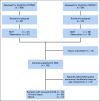Long-Term Outcomes and Genetic Predictors of Response to Metastasis-Directed Therapy Versus Observation in Oligometastatic Prostate Cancer: Analysis of STOMP and ORIOLE Trials
- PMID: 36001857
- PMCID: PMC10166371
- DOI: 10.1200/JCO.22.00644
Long-Term Outcomes and Genetic Predictors of Response to Metastasis-Directed Therapy Versus Observation in Oligometastatic Prostate Cancer: Analysis of STOMP and ORIOLE Trials
Abstract
Clinical trials frequently include multiple end points that mature at different times. The initial report, typically based on the primary end point, may be published when key planned co-primary or secondary analyses are not yet available. Clinical Trial Updates provide an opportunity to disseminate additional results from studies, published in JCO or elsewhere, for which the primary end point has already been reported.The initial STOMP and ORIOLE trial reports suggested that metastasis-directed therapy (MDT) in oligometastatic castration-sensitive prostate cancer (omCSPC) was associated with improved treatment outcomes. Here, we present long-term outcomes of MDT in omCSPC by pooling STOMP and ORIOLE and assess the ability of a high-risk mutational signature to risk stratify outcomes after MDT. The primary end point was progression-free survival (PFS) calculated using the Kaplan-Meier method. High-risk mutations were defined as pathogenic somatic mutations within ATM, BRCA1/2, Rb1, or TP53. The median follow-up for the whole group was 52.5 months. Median PFS was prolonged with MDT compared with observation (pooled hazard ratio [HR], 0.44; 95% CI, 0.29 to 0.66; P value < .001), with the largest benefit of MDT in patients with a high-risk mutation (HR high-risk, 0.05; HR no high-risk, 0.42; P value for interaction: .12). Within the MDT cohort, the PFS was 13.4 months in those without a high-risk mutation, compared with 7.5 months in those with a high-risk mutation (HR, 0.53; 95% CI, 0.25 to 1.11; P = .09). Long-term outcomes from the only two randomized trials in omCSPC suggest a sustained clinical benefit to MDT over observation. A high-risk mutational signature may help risk stratify treatment outcomes after MDT.
Trial registration: ClinicalTrials.gov NCT01558427 NCT02680587.
Conflict of interest statement
Long-Term Outcomes and Genetic Predictors of Response to Metastasis-Directed Therapy Versus Observation in Oligometastatic Prostate Cancer: Analysis of STOMP and ORIOLE Trials
The following represents disclosure information provided by authors of this manuscript. All relationships are considered compensated unless otherwise noted. Relationships are self-held unless noted. I = Immediate Family Member, Inst = My Institution. Relationships may not relate to the subject matter of this manuscript. For more information about ASCO's conflict of interest policy, please refer to
Open Payments is a public database containing information reported by companies about payments made to US-licensed physicians (
Figures



References
-
- Ost P, Reynders D, Decaestecker K, et al. Surveillance or metastasis-directed therapy for oligometastatic prostate cancer recurrence: A prospective, randomized, multicenter phase II trial. J Clin Oncol. 2018;36:446–453. - PubMed
-
- Van der Eecken K, Vanwelkenhuyzen J, Deek MP, et al. Tissue- and blood-derived genomic biomarkers for metastatic hormone-sensitive prostate cancer: A systematic review. Eur Urol Oncol. 2021;4:914–923. - PubMed
Publication types
MeSH terms
Associated data
Grants and funding
LinkOut - more resources
Full Text Sources
Medical
Research Materials
Miscellaneous

